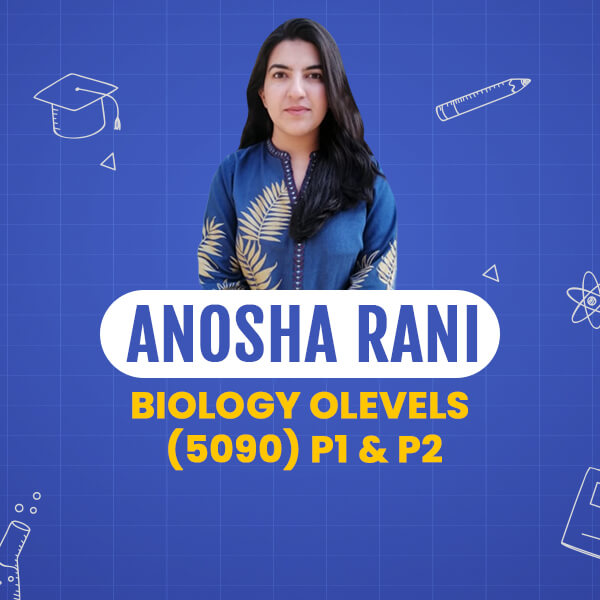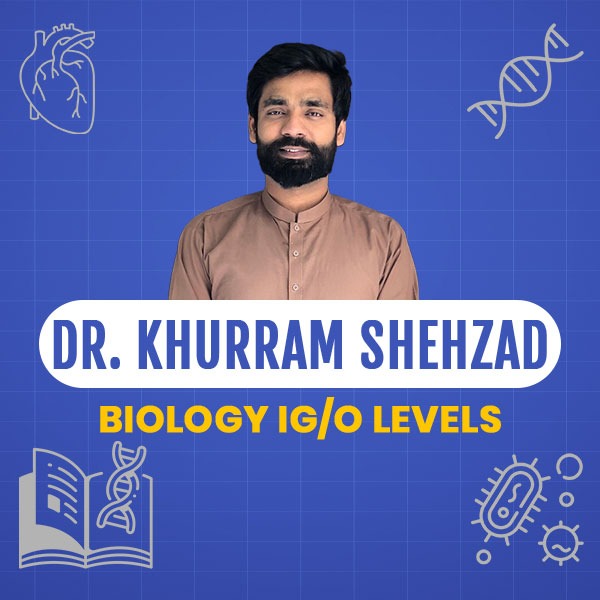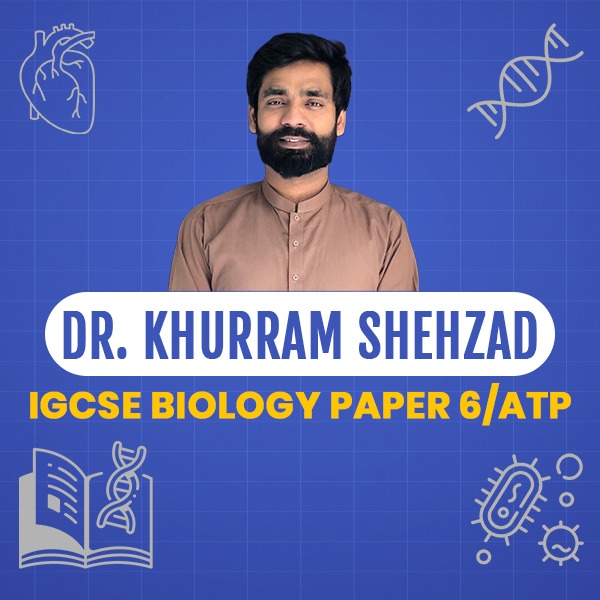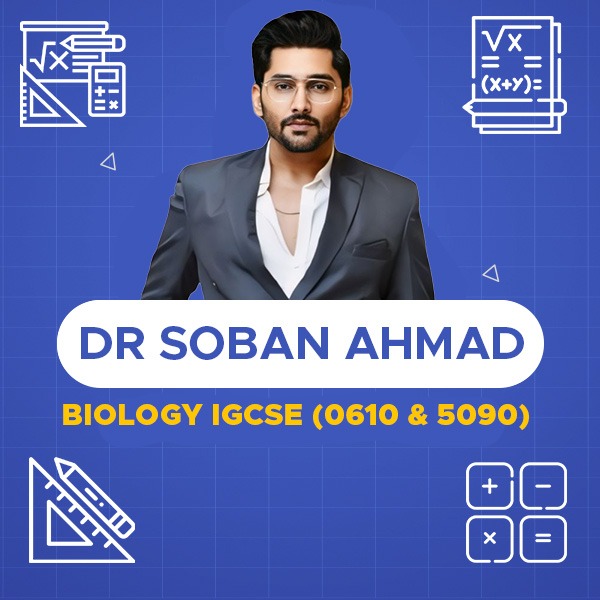
 Lectures: 22 Topics , 183 Sub Topics
Lectures: 22 Topics , 183 Sub Topics Duration:
Duration:
 Language: English
Language: English Enrolled:
0
Students
Enrolled:
0
Students Access on Mobile and TV
Access on Mobile and TV Premium content
Premium content
Biology- GCSE / IGCSE (5090 & 0610)
What will i learn?
- Skills for analyzing scientific information and understanding its implications.
- Conceptual way of learning and past paper practice will be exercised and a healthy learning environment will be created
- Effective communication and scientific literacy
- By the end of these sessions students will find the book content easy to understand and will be able to solve questions on their own .
- Critical thinking and problem-solving skills
Learn O Levels Biology (5090) / IGCSE (0610) With TORUS !
Welcome to the O Levels / IGCSE Biology course, where we embark on a detailed exploration of the science of life. This course is meticulously crafted to prepare you for the rigorous examinations while fostering a deep appreciation and understanding of Biological principles.
Throughout this journey, we will unravel the intricacies of life from the molecular level to entire ecosystems. Starting with the building blocks of life—cells and their organelles—we will investigate their structures, functions, and interactions. You will gain insights into cellular processes such as respiration, photosynthesis, and cell division, understanding how these processes sustain life.
Evolutionary biology will be a cornerstone of our exploration, we will explore the mechanisms of natural selection, and analyze the evidence for evolutionary theory. We will discuss adaptation, speciation, and the diversity of life forms that have evolved over billions of years.
The course will also delve into genetics and inheritance, where you will learn about DNA structure, replication, and the principles of Mendelian genetics. We will explore how genes determine traits, how genetic variations arise, and their implications in human health and biodiversity.
Ecology, another crucial aspect of biology, will be thoroughly covered. You will study the interactions between organisms and their environments, including concepts of populations, communities, ecosystems, and the impact of human activities on biodiversity and ecological balance.
Moreover, contemporary issues in Biology such as biotechnology, conservation biology, and the ethical implications of scientific advancements will be discussed, preparing you to critically evaluate and engage with current debates and challenges in the field.
Assessment:
Past Paper Practice: Incorporate regular practice with past examination papers (both yearly and topicals) to familiarize students with the format and types of questions they may encounter. This practice will also aid in developing time management skills and identifying common question patterns.
Coursework: Complete coursework assignments that demonstrate your ability to apply biological principles to solve problems, analyze data, and communicate scientific findings effectively.
By the end of this course, you will have gained a solid foundation in Biology, equipped with the knowledge, skills, and confidence to excel in your O Levels / IGCSE examinations and to appreciate the profound impact of biology on our world. Join us in this enriching journey as we uncover the wonders of life through the lens of science.
Get Registered Now !
- Characteristics of organisms
- The biological classification system
- Keys
- Kingdoms
- Groups within the animal and plant kingdoms
- Viruses
- Human nervous system and Sense organs
- Hormones
- Coordination and response in plants
- The CNS and PNS
- Structure and function of sensory, relay and motor neurone
- Difference between voluntary and involuntary actions
- Reflex action and reflex arc
- Understanding of the various layers of the eye with their role
- Detailed structure of eye
- The role of the iris in the pupil reflex
- Significance of the retina in image formation via rod and cone cells
- Role of the ciliary muscles in the accomodation
- Glands and Hormones
- Geotropism and Phototropism in plants
- Role and importance of Auxin in plants
- Roles of glands in the maintenance of blood glucose level, water balance
- Various important glands and hormones in human body and their importance
- Adrenaline
- Synapses
- Diabetes and its treatment
- Controlling of body temperature and the structure of skin (detailed)
- Hypothalamus
- Maintaining internal environment
- Control of blood glucose concentration
- Mechanism of negative feedback
- Medicinal drugs and its Misuse
- Reasons for antibiotic resistant in bacteria
- Concept of asexual and sexual reproduction
- Example of asexual reproduction (tube formation in potatoes)
- Gametes (detailed)
- Sexual reproduction in flowering plants
- Male and female gametes in flowering plants
- Pollination and its types (detailed)
- Fertilisation in flower
- Seed formation and seed germination (detailed)
- Comparing sexual and asexual reproduction
- Human reproductive system including gametes (detailed)
- Fertilisation and development
- Implantation and Placenta
- Amniotic sac
- Testosterone and oestrogen
- Menstrual cycle and hormones involved in it (detailed)
- Sexually transmitted infections
- Preventing HIV transmissions
- Chromosomes and cell division
- Chromosomes in haploid and diploid cells
- Mitosis (detailed)
- Meiosis (detailed)
- Genes and alleles
- Genotype and Phenotype
- Dominant and recessive alleles
- Codominance with example of ABO blood group
- Genes and fertilization
- Genetic/ pedigree diagrams
- Sex determination and pure breeding
- DNA and Protein synthesis (detailed)
- Specialised cells and stem cells
- Basic concept about variation
- Continuous and discontinuous variation
- Causes of variation
- Causes of genetic variation
- Adaptive features of Xerophytes
- Adaptive features of halophytes
- Darwin's theory of selection (detailed) and its example
- Antibiotic resistance in bacteria
- Malarial life cycle
- Cancer cells
- Sickle cell anaemia
- Selective breeding
- Artificial selection
- Comparing natural selection and selective breeding
- Ecology and energy flow
- Nutrient cycles including Carbon and Nitrogen cycles
- Population size and factors affecting population growth
- Trophic levels and pyramid of biomass
- Artificial fertilisers
- Nitrogen fixing bacteria
- Concept of populations including birth and death rate
- Factors affecting population growth
- Pyramid of number
- Pyramid of energy
- Efficiency of energy transfer
- Age pyramids
- Human pressures on ecosystems and its conservations
- Food production and ways of increasing food production
- Monoculture
- Negative impact of monocultures
- Intensive livestock production and its disadvantages on our environment
- Habitat destruction
- Deforestation and Pollution (detailed)
- Eutrophication
- Pesticides and its effect
- Conservations (detailed)
- Human excretory system
- How urea is produced (deamination)
- Excretory products and urine formation (detailed)
- Longitudinal section of the kidney with elaboration of its multiple layers
- Structure of the nephron
- Formation of the urine through ultrafiltration and selective reabsorption
- Significance of metabolism with regard to producing metabolic waste materials in the body
- Role of the kidneys in the osmoregulation
- Role of liver in detoxification
- Aerobic and anaerobic respiration
- Difference between aerobic and anaerobic respiration
- Gas exchange surfaces and human breathing system
- Human breathing system ; pathway to lungs via nose to alveoli (detailed)
- Gas exchange in lungs
- Comparing inspired and expired air
- Breathing movements ; inspiration and expiration
- Respiration and using energy
- Exercise and breathing rate ; concept of oxygen debt
- Cell structure
- Cells and organisms
- Sizes of specimen
- Diffusion , Osmosis and Active transport
- Carbohydrates, Proteins and Fats
- Structure of DNA (detailed)
- The enzymatic activity with emphasis on the lock and key hypothesis
- Characteristics of enzymes
- Active site and its function
- Factors affecting rate of enzyme actions
- Biological catalyst
- Making carbohydrate using light energy
- Structure of leaf
- Factors affecting photosynthesis , Importance of photosynthesis
- Limiting Factors
- Uses of glucose and testing leaves for starch
- Diet and Digestion
- Alimentary canal and its function (detailed from mouth to anus)
- Structure and types of teeth
- The role of peristalsis in moving food along the digestive tract
- Chemical and physical digestion and difference between them
- Chemical digestion and absorption of the carbohydrate, protein and fats
- Absorption and assimilation
- Structure of small and large intestine
- Adaptations of the villi to absorb food
- Chemical digestion in small intestine
- Structure and function of liver and pancreas with respect to human digestion
- Enzymes in human digestive system
- Bile and its function
- Cholera and precautionary measures
- Plants transport system including xylem and phloem
- Water uptake through root hairs
- Translocation of manufactured food
- Pathway of water through plant
- Transpiration and transpiration pull (detailed)
- Measuring of transpiration rates
- Concept of sources and sink
- Conditions that affect transpiration rate
- Circulatory system and oxygenating blood
- Differentiate between double and single circulatory system
- Indepth knowledge of the internal and external heart structure
- Coronary arteries
- Preventing and treating Coronary Heart Disease (CHD)
- The pumping mechanism of the heart
- How heart beats with detailed explanation of systole , diastole , atrioventricular valves , semilunar valves in squeezing blood out of heart
- Blood vessels including arteries ,veins and capillaries
- Difference between arteries, veins and capillaries with respect to their functions, structure of their walls, width of lumen etc.
- Major blood vessels and their names according to organ with which they are connected
- Human blood including (RBC's , WBC's, Platelets )
- Lymph and lymphatic system
- Main components of blood plasma and their function
- Transmissions of pathogens and Immune response
- Memory cells
- Active and passive immunity
- Vaccination
- Body defences
- Antibodies
- what is biotechnology ? , and using microorganisms
- Making use of anaerobic respiration in yeast
- Making biofuels
- Making bread
- Making use of enzymes for biological washing powders, extracting juices and making lactose free milk (detailed)
- Production of penicillin in fermenter (detailed)
- Genetic modification/engineering (detailed)
- Advantages and disadvantages of genetically modified crops
- How genetic modification is done
| Title | Lectures | Price |
|---|---|---|
| Inquiry Based Session-1 lesson | 1 | 11$ |
| Regular Package/ 4 lesson | 4 | 44$ |
| Standard Package/8 Lesson | 8 | 75$ |
| Premium Package/12 | 12 | 105$ |
| Fast Track/16 Lesson | 16 | 132$ |
| Regular Group | 16 | $ |
| Anyone who wants to learn Biology can join this course. |
| Students of O levels & IGCSE can take these lessons. |
| A deep understanding of biological concepts and principles |
Other Related Courses




Reviews
0
0 Ratings
Detailed Rating
About The Instructor

 (0)
(0)This is Najia Alim having over 16 years experience of teaching students from multiple streams including Cambridge International Examination. My exeprtise cover the criteria required for IGCSE,GCSE & A-Levels Biology.
Skills
Student engagement
Curriculum Development
Student-centered learning
Online teaching platforms including Zoom, Google Meet, Teams, G-Classroom etc.
Excellent detailed Knowledge of Biology subject
Working knowledge of Computer and Internet.
Teaching Methodology for O/A Levels & IGCSE
-
Structured Curriculum Delivery: Adhere to a well-organized curriculum that aligns with the O/A Level syllabus. Ensure that all topics are covered comprehensively and in a logical sequence.
-
Past Paper Practice: Incorporate regular practice with past examination papers (both yearly and topicals) to familiarize students with the format and types of questions they may encounter. This practice will also aid in developing time management skills and identifying common question patterns.
- Supportive Learning Environment: Foster a supportive and inclusive classroom atmosphere where students feel comfortable asking questions and expressing their ideas.
-
Visual Aids: Utilize diagrams, charts, and other visual aids to enhance understanding and retention of complex concepts. Visual representations will be integrated into lectures to provide clarity and support learning.
- Continuous Improvement: Reflect on teaching practices and student outcomes regularly to refine methodologies and enhance educational effectiveness.
AIM:
- The overall goal is to not only polish the students in term of their subject knowledge but also to score grades A & A* in the Examination.

0 Comments
Show More